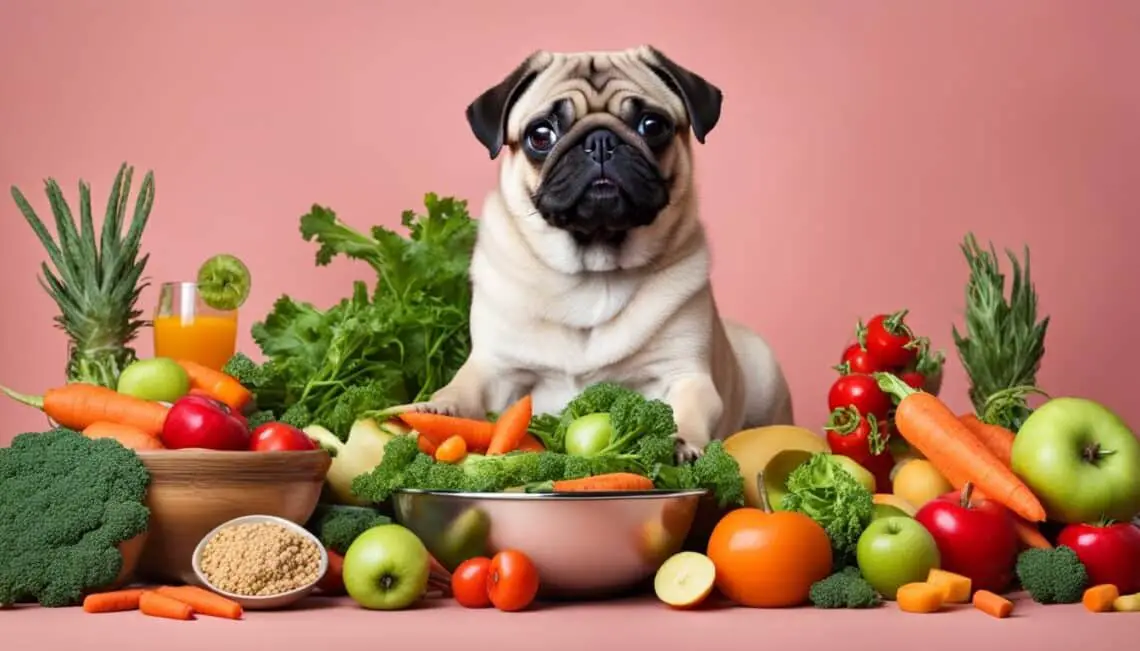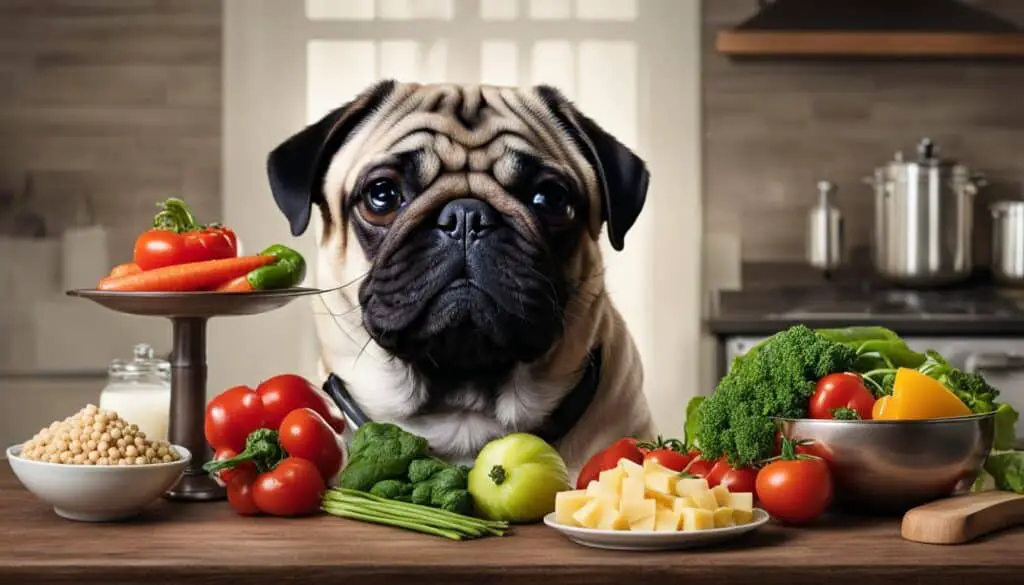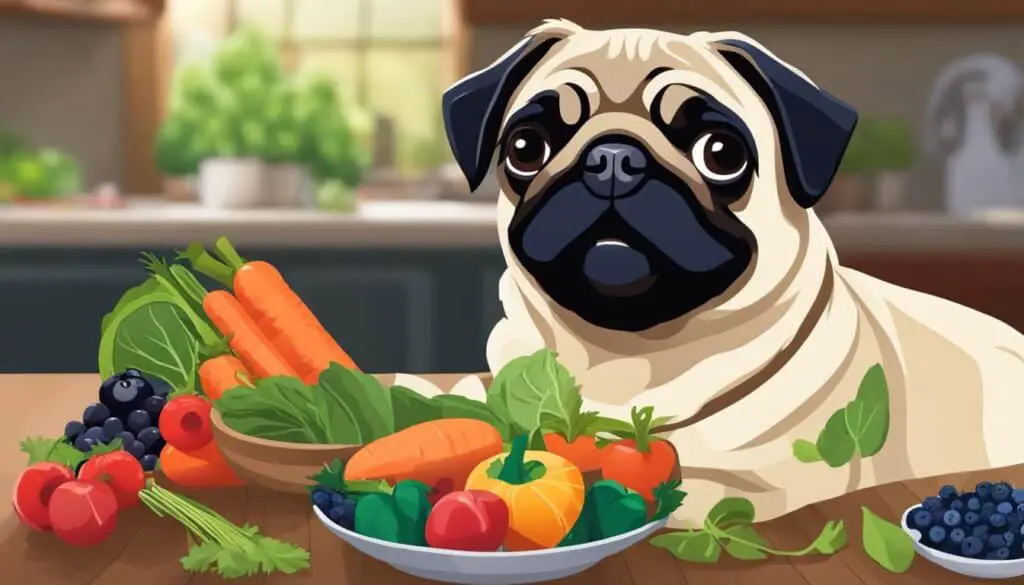When it comes to caring for your beloved Pug, providing them with a nutritious and balanced diet is of utmost importance. The right nutrition can make a significant difference in their overall health and well-being. In this article, I will share some essential tips and recommendations for feeding your Pug, ensuring they receive the proper nutrients they need to thrive.
Key Takeaways:
- Choosing the right food for your Pug is crucial for their nutrition and well-being.
- Dry kibble is generally better for their teeth, while wet canned food can lead to runny stools.
- Scheduled feeding and portion control are important for Pug health, especially for adult Pugs.
- Look for high-quality proteins, all-natural preservatives, and healthy fats in your Pug’s diet.
- Grain-free options can be beneficial for Pugs with allergies.
The Best Food for Pug Puppies and Adults
Choosing the right food for your Pug is crucial for their overall health and well-being. Pug puppies have different nutritional needs compared to adolescent and adult Pugs, so it’s important to consider their age when planning their meals. Pug puppies should be fed three times a day to support their growth and development. As they transition into adolescent and adult stages, you can reduce their meals to two to three times a day while keeping a close eye on their weight.
When it comes to the ingredients, opt for high-quality proteins such as chicken, turkey, lamb, fish, bison, and beef. These protein sources provide essential amino acids that are vital for muscle development and maintenance. Avoid foods that contain synthetic preservatives, artificial coloring dyes, soy, and high grain counts, as these ingredients can potentially trigger allergies or digestive issues in Pugs.
“Feeding your Pug a balanced and nutritious diet is key to ensuring their overall health and happiness.”
Consider adding beneficial extras to your Pug’s diet, such as glucosamine and chondroitin for joint health, omega-3 and omega-6 fatty acids for a healthy coat, probiotics for immune support, and antioxidants for disease prevention. These additional supplements can provide your Pug with extra support and promote their well-being.
Table: Protein Sources for Pugs
| Protein Source | Description |
|---|---|
| Chicken | Lean and easily digestible protein source |
| Turkey | Low-fat protein option with essential nutrients |
| Lamb | Rich in essential amino acids and minerals |
| Fish | Provides omega-3 fatty acids for a healthy coat |
| Bison | Lean and nutrient-dense protein source |
| Beef | Rich in iron and essential amino acids |
It’s important to note that every Pug is unique, and their dietary needs may vary. Consult with your veterinarian to determine the best food options for your Pug based on their individual requirements. By providing a balanced and nutritious diet, you can ensure that your Pug thrives and enjoys a happy, healthy life.
Raw Food Diet for Pugs
Some Pug owners opt for a raw food diet for their pets. A natural, raw diet can help control allergies and prevent common health issues such as obesity, joint problems, dental issues, and digestive complaints. Dogs’ digestive systems are best suited to fresh, high-protein-based diets that mimic what they would eat in the wild. This includes meat, bones, and offal. A raw diet can be homemade, with chicken and rice being a popular option, or you can choose a commercial, organic raw food brand.
Grain-free diets are often recommended for Pugs with allergies, and some brands include fruits and vegetables to ensure a balanced nutritional profile. When switching your Pug to a new diet, do it gradually to avoid any stomach upset or diarrhea. It’s important to note that raw food diets may not be suitable for all Pugs, so consult with your veterinarian before making any changes. Remember, providing a healthy diet is crucial for Pug weight management and overall health.
The Benefits of a Raw Food Diet for Pugs
Switching your Pug to a raw food diet can have several benefits for their health and wellbeing. Here are some key advantages:
- Control Allergies: Many Pugs suffer from food allergies. A raw food diet eliminates common allergens found in processed kibble, such as grains and artificial additives, which can contribute to skin rashes, ear infections, and digestive issues.
- Weight Management: Pugs are prone to obesity, which can lead to serious health problems. A raw food diet provides a more natural, balanced approach to portion control, ensuring your Pug maintains a healthy weight.
- Improved Digestion: Raw food is easier for dogs to digest compared to processed kibble. It contains enzymes and beneficial bacteria that support optimal gut health, reducing the risk of constipation, diarrhea, and other digestive issues.
- Dental Health: Chewing on raw meat and bones helps to clean your Pug’s teeth naturally, reducing the risk of dental problems such as tartar buildup and gum disease.
- Enhanced Energy and Vitality: A raw food diet provides the essential nutrients and natural enzymes that Pugs need for optimal health and vitality. Many owners report that their Pugs have increased energy, shinier coats, and improved overall wellbeing on a raw food diet.
While there are many benefits to a raw food diet, it’s important to consult with your veterinarian to ensure it’s the right choice for your Pug. They can provide personalized advice and guidance based on your Pug’s individual needs and health conditions.
Table: Comparing Different Types of Pug Diets
| Diet Type | Pros | Cons |
|---|---|---|
| Dry Kibble | – Convenient – Enriched with essential nutrients – Good for dental health | – Can be high in carbohydrates – May contain artificial additives – Some Pugs may have difficulty chewing |
| Wet Canned Food | – Moisture-rich – Easy to eat for Pugs with dental issues – Variety of flavors available | – Can lead to weight gain – May cause runny stools – Higher cost |
| Raw Food Diet | – Provides a natural, species-appropriate diet – Controls allergies and improves digestion – Supports weight management | – Requires careful meal planning – Potential risk of bacterial contamination – May not be suitable for all Pugs |
Conclusion
Feeding your Pug a balanced and nutritious diet is essential for their health and wellbeing. As a responsible pet owner, it’s important to understand their specific nutrient requirements and prioritize their diet essentials.
Whether you choose dry kibble or wet food, it’s crucial to consider their dental health and stool consistency. Dry kibble is generally better for their teeth, while wet canned food can lead to runny stools. However, if your Pug has missing teeth or struggles with dry food, you can mix in a bit of canned food.
Scheduled feeding is recommended for portion control, allowing you to manage their intake and prevent overeating. Additionally, providing dry snacks in between meals ensures they stay satisfied throughout the day. When determining the amount of food to feed your Pug, it’s best to follow the feeding instructions on the packaging of trusted brands.
When it comes to their diet, it’s important to avoid ingredients such as synthetic preservatives, artificial coloring dyes, and soy. Instead, look for all-natural preservatives, high-quality proteins, and healthy fats. Grain-free options can be beneficial for Pugs with allergies, and consider adding helpful extras like glucosamine and chondroitin, omega-3 and 6, probiotics, and antioxidants for their overall health.
Lastly, some Pug owners opt for a raw food diet, which can have potential benefits for their allergies and overall health. However, it’s vital to consult with your veterinarian before making any dietary changes to ensure it is suitable for your Pug’s specific needs.
By providing a nutritious and balanced diet, you can meet your Pug’s nutrient requirements and support their optimal health and happiness.
FAQ
What is the best feeding schedule for Pug puppies?
Pug puppies should be fed three times a day, with healthy snacks in between meals.
How many meals should adolescent and adult Pugs have?
Adolescent and adult Pugs can be fed two to three meals a day, along with dry snacks in between.
How much food should I feed my Pug?
The amount of food depends on your Pug’s weight. Follow the feeding instructions on trusted brands’ packaging.
What ingredients should I avoid in my Pug’s food?
Avoid synthetic preservatives, artificial coloring dyes, and soy. Look for all-natural preservatives and high-quality proteins.
Are grain-free diets recommended for Pugs?
Grain-free options can be beneficial for Pugs with allergies. Look for gluten-free grains if needed.
Can I feed my Pug a raw food diet?
Some Pug owners choose a raw food diet for their pets. Consult with your veterinarian before making any changes.
How should I switch my Pug to a new diet?
When switching diets, do it gradually to avoid stomach upset or diarrhea.
What should I consider when choosing a Pug’s food?
Consider their specific needs, including high-quality protein sources, all-natural preservatives, and added extras like joint health supplements and antioxidants.







No Comments